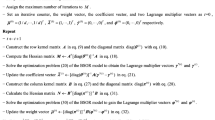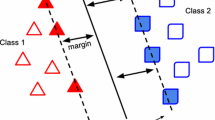Abstract
Linear programming support vector regression shows improved reliability and generates sparse solution, compared with standard support vector regression. We present the v-linear programming support vector regression approach based on quantum clustering and weighted strategy to solve the multivariable nonlinear regression problem. First, the method applied quantum clustering to variable selection, introduced inertia weight, and took prediction precision of v-linear programming support vector regression as evaluation criteria, which effectively removed redundancy feature attributes and also reduced prediction error and support vectors. Second, it proposed a new weighted strategy due to each data point having different influence on regression model and determined the weighted parameter p in terms of distribution of training error, which greatly improved the generalization approximate ability. Experimental results demonstrated that the proposed algorithm enabled the mean squared error of test sets of Boston housing, Bodyfat, Santa dataset to, respectively, decrease by 23.18, 78.52, and 41.39%, and also made support vectors degrade rapidly, relative to the original v-linear programming support vector regression method. In contrast with other methods exhibited in the relevant literatures, the present algorithm achieved better generalization performance.





Similar content being viewed by others
References
Asuncion A, Newman DJ (2007) UCI machine learning repository. School of Information and Computer Sciences, University of California, Irvine. http://mlearn.ics.uci.edu/MLRepository.html. Accessed 6 Mar 2007
Aïmeur E, Brassard G, Gambs S (2007) Quantum clustering algorithms. In: Proceedings of the 24th international conference on machine learning, vol 227. pp 1–8
Butterworth R, Piatetsky-Shapiro G, Simovici DA (2005) On feature selection through clustering. Fifth IEEE Int Conf Data Min 11:27–30
Cao LJ, Chua KS, Chong WK et al (2003) A comparison of PCA, KPCA, and ICA for dimensionality reduction in support vector machine. Neurocomputing 55(1–2):321–336
Chen YW, Lin CJ (2006) Combining SVMs with various feature selection strategies. In: Guyon I, Gunn S, Nikravesh M et al (ed) Feature extraction: foundations and applications. Springer, Berlin, pp 315–324
Corsini P, Lazzerini B, Marcelloni F (2005) A new fuzzy relational clustering algorithm based on the fuzzy C-means algorithm. Soft Comput 9(6):439–447
Cunningham P (2007) Dimension reduction. Technical Report UCD-CSI-2007-7
Drucker H, Burges CJC, Kaufman H et al (1996) Support vector regression machines. Adv Neural Inf Process Syst 9:155–161
Dy JG, Brodley CE (2004) Feature selection for unsupervised learning. J Mach Learn Res 5:845–889
Fodor IK (2002) A survey of dimension reduction techniques. Technical Report UCRL-ID-148494
Gershenfeld N, Weigend A (1994) The Santa Fe time series competition data. http://www-psych.stanford.edu/~andreas/Time-Series/SantaFe.html. Accessed 10 May 2008
Guyon I, Elisseeff A (2003) An introduction to variable and feature selection. J Mach Learn Res 3:1157–1182
Horn D, Gottlieb A (2001) The method of quantum clustering. Proc Neural Inf Process Syst 14:769–776
Horn D, Gottlieb A (2002) Algorithm for data clustering in pattern recognition problems based on quantum mechanics. Phys Rev Lett 88(1):018702
Hyvärinen A, Oja E (2000) Independent component analysis: algorithms and applications. Neural Netw 13(4–5):411–430
Jolliffe IT (2002) Principal component analysis, 2nd edn. Springer, New York
Mangasarian OL, David R (2002) Large scale kernel regression via linear programming. Mach Learn 46(1–3):255–269
Pedroso JP, Murata N (1999) Support vector machines for linear programming: motivation and formulations. BSIS Technical Report 99-2, Riken Brain Science Institute, Wako-shi, Saitatma, Japan
Reynolds RG (2002) Cultural algorithms: a tutorial. Wayne State University, Detroit
Schölkopf B, Smola A (2002) Learning with kernels. MIT Press, Cambridge
Schölkopf B, Bartlett P, Smola A et al (1998) Shrinking the tube: a new support vector regression algorithm. Adv Neural Inf Process Syst 11:330–336
Schölkopf B, Smola A, Müller K (1999) Kernel principal component analysis. In: Schölkopf B, Burges C, Smola A (ed) Advances in kernel methods: support vector learning. MIT Press, Cambridge, pp 327–352
Smola AJ, Schölkopf B (2004) A tutorial on support vector regression. Stat Comput 14(3):199–222
Smola A, Schölkopf B, Rätsch G (1999) Linear programs for automatic accuracy control in regression. Ninth Int Conf Artif Neural Netw 2:575–580
Suykens JAK, De Brabanter J, Lukas L et al (2000) Weighted least squares support vector machines: robustness and sparse approximation. Neurocomputing 48(1–4):85–105
Suykens JAK, Gestel TV, Vandewalle J et al (2003) A support vector machine formulation to PCA analysis and its kernel version. IEEE Trans Neural Netw 14(2):447–450
Vapnik V (1995) The nature of statistical learning theory. Springer, Berlin
Vapnik V (1998) Statistical learning theory. Wiley, New York
Vapnik V, Golowich S, Smola A (1996) Support vector method for function approximation, regression estimation, and signal processing. Adv Neural Inf Process Syst 9:281–287
Vlachos P (2005) StatLib—datasets archive. http://lib.stat.cmu.edu/datasets. Accessed 6 Mar 2007
Zheng WM, Zou CR, Zhao L (2005) An improved algorithm for kernel principal component analysis. Neural Process Lett 22(1):49–56
Zhou W, Zhang L, Jiao L (2002) Linear programming support vector machines. Pattern Recognit 35(12):2927–2936
Acknowledgments
This paper was supported by National Science Foundation for Distinguished Young Scholars (No. 60625302), National Natural Science Foundation of China (General Program) (No. 60704028), Program for Changjiang Scholars and Innovative Research Team in University (No.IRT0721), the 111 Project (No.B08021), Shanghai Leading Academic Discipline Project (No.B504).
Author information
Authors and Affiliations
Corresponding author
Rights and permissions
About this article
Cite this article
Yu, Y., Qian, F. & Liu, H. Quantum clustering-based weighted linear programming support vector regression for multivariable nonlinear problem. Soft Comput 14, 921–929 (2010). https://doi.org/10.1007/s00500-009-0478-1
Published:
Issue Date:
DOI: https://doi.org/10.1007/s00500-009-0478-1




